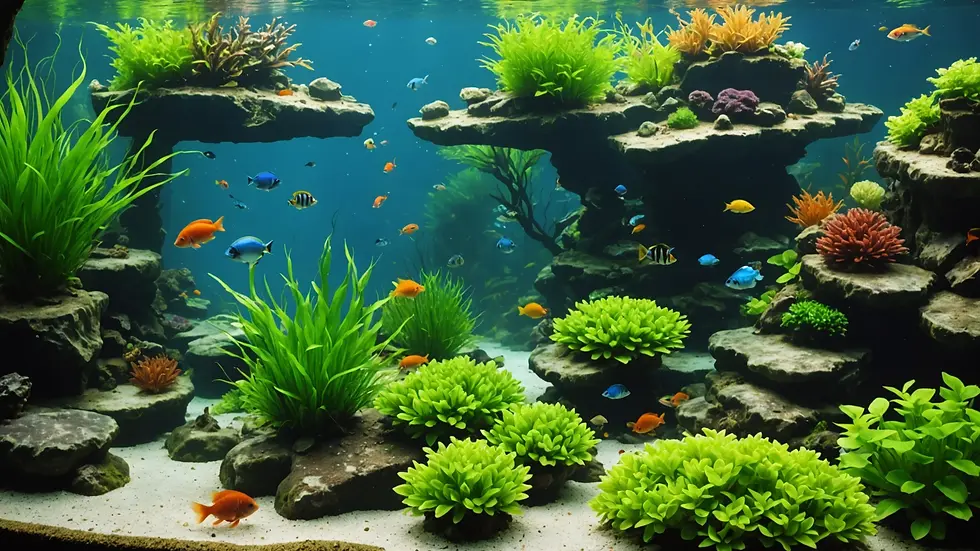Exploring the Benefits of Live Food for Aquarium Fish: A Closer Look
- Jyotiraj Borah
- Feb 7
- 4 min read
Feeding fish can be a challenging task for any aquarium enthusiast. Many opt for commercial pellets and flakes, but a growing number are discovering the advantages of offering live food. This guide explores the benefits of live food for aquarium fish, highlighting its nutritional advantages, behavioral benefits, and tips for sourcing and maintaining live food in your home aquarium.
What is Live Food?
Live food includes any living organisms that can serve as sustenance for fish. Common options are brine shrimp, bloodworms, daphnia, and even small insects. The movement of these organisms often attracts fish more than stationary food, mimicking their natural hunting behaviors.
Understanding the differences between dry food (flakes and pellets) and live food is essential. This distinction has significant implications for fish health and the overall balance of your aquarium ecosystem.
Nutritional Value of Live Food
One of the standout benefits of live food is its exceptional nutritional profile.
Brine shrimp, for example, are particularly rich in omega-3 fatty acids, promoting healthy growth and strong immune systems in fish. Studies show that diets supplemented with live brine shrimp can enhance a fish's growth rate by up to 20% compared to those fed only dry food.
Live food contains digestive enzymes that aid in processing nutrients efficiently, further emphasizing the nutritional superiority of feeding live organisms.
Enhanced Feeding Practices
Introducing live food into your aquarium often sparks natural feeding behaviors in your fish.
When presented with live food, fish may engage in what can only be described as a feeding frenzy. This not only brings a lively aspect to your tank but also bolsters their physical activity levels and overall health.
For example, smaller species like tetras can become much more engaging when offered live foods, encouraging them to swim and move around actively, which is crucial for their well-being.
Behavioral Benefits
Reduction in Stress Levels
Utilizing live food can significantly alleviate stress in fish.
Stress can adversely impact fish health, manifesting in weakened immune systems and unusual behaviors. In their natural habitat, many species are hunters, exhibiting various behaviors that keep them socially interactive and stimulated.
By introducing live food, aquarists create a more enriching environment. A stimulated and healthy fish is less likely to develop stress-related issues.
Encouragement of Natural Behaviors
Providing an opportunity for fish to hunt fosters natural behaviors typically observed in the wild.
For example, cichlids display territorial behaviors when hunting, which is not only exciting to watch but reinforces their instincts. Such interactions contribute to a more dynamic, vibrant aquarium environment.

Types of Live Food for Aquarium Fish
Understanding the dietary needs of your fish is vital for creating a balanced ecosystem.
Brine Shrimp: A favorite among aquarists for its high nutritional content and ease of cultivation. You can purchase brine shrimp eggs and hatch them at home, ensuring a continuous supply of live food.
Bloodworms: High in protein, these worms are suitable for most freshwater fish, aiding their growth and health.
Daphnia: Commonly referred to as "water fleas," these microscopic crustaceans are ideal for smaller fish, especially fry. They are easy to culture indoors.
Mosquito Larvae: A cost-effective option, larvae can be collected from clean standing water sources.
Live Insects: Some carnivorous fish benefit from live insects like crickets or mealworms, but ensure they are appropriately sized and pesticide-free.

Sourcing Live Food
Cultivating Your Own Live Food
Many aquarists prefer cultivating their own live food to ensure freshness.
For instance, setting up a simple brine shrimp hatchery requires minimal investment and can yield a sustainable supply of food. Resources like online guides can help newcomers establish their cultures effectively.
Purchasing Live Food
If cultivating live food is impractical, purchasing live food from reputable suppliers is an excellent alternative. Many local fish stores and specialty online retailers provide high-quality live food options.
Always verify the cleanliness and sustainability of your sources to minimize the risk of introducing disease or parasites to your aquarium.
Feeding Considerations
Frequency of Feeding Live Food
The frequency of feeding live food varies by fish species and size. Smaller fish may benefit from daily offerings, while larger fish can handle live food 2-3 times a week as a supplement to their diet.
It’s crucial to cater the feeding schedule based on the fish's life stage and general health. Fry and juveniles should have more frequent feedings due to their rapid growth requirements.
Monitoring Fish Health
Incorporating live food necessitates regular health monitoring for your fish. Observe for any behavioral changes or signs of wellness or illness.
Initially, some fish might experience stress when introduced to live food, so careful observation is vital to ensure they adapt positively to this feeding practice.

Benefits Beyond Nutrition
Incorporating live food into your fish's diet offers numerous advantages that go beyond just nutritional value. It encourages natural instincts, promotes healthy behaviors, and improves their overall living conditions.
Whether you choose to cultivate your own live food or purchase it, integrating live organisms into your feeding routine can transform your fish's experience. Through careful observation and mindful feeding practices, you can create an engaging and nutritious environment for your aquatic pets.
Exploring live food enhances not only your fish's dietary needs but also enriches their lives and the enjoyment you gain as an aquarium enthusiast. Happy fish-keeping!




Comments